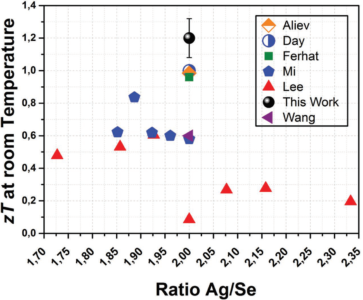
New thermoelectric material shows great potential for wearable devices, embedded to clothing and accessories, and other flexible technologies
One of the biggest challenges for the advancement of wearable devices, embedded to clothing and accessories, which would be capable, for example, of continuously measuring and transmitting vital sign data, is the availability of power without the need for large batteries.
Thermoelectric materials – in which a temperature difference between two points of the material creates an electric current or vice versa – make it possible to obtain the electrical energy used by the device from the temperature difference between the surface of the human body and the ambient air.
The efficiency of these materials is characterized by their figure of merit $zT$, which is directly proportional to the electrical conductivity and the absolute temperature of the material and inversely proportional to its thermal conductivity. Thus, obtaining new materials with high value for $zT$ at room temperature and low thermal conductivity is a key element for the development of a new generation of wearable devices based on thermoelectric heat recovery.
Most of the materials of interest for the use of this thermoelectric effect are semiconductors, as is the case of Selenium-based materials. Thus, J.A. Perez-Taborda et al. [1] have developed a new thin film deposition technique, called pulsed hybrid reactive magnetron sputtering, in which it is possible to produce selenium-based films with high crystallinity and different compositions in a few minutes.
Using the technique, the group obtained [2] a new n-type $ \rm Ag_2 Se $ thin film that presented, at room temperature, superior performance to materials already used in commercial applications, in addition to being composed of more abundant chemical elements.

Comparison between the value of $zT$ at room temperature for the n-type $\rm Ag_2 Se$ thin film obtained in this work, and other results from the literature for materials with different proportions of silver and selenium. The high value of $zT$ for the thin film is explained by the low thermal conductivity $\rm (0.64 \pm 0.1 W\, m^{-1}\, K^{-1})$ provided by its nanostructure.
The high value of $ zT = 1.2 $ for the obtained film is explained by the low thermal conductivity $ \rm (0.64 \pm 0.1 W\, m^{-1}\, K^{-1})$ provided by its nanostructure . This breakthrough in the production of $ \rm Ag_2 Se$ thin films with high thermoelectric efficiency opens new possibilities for wearable devices, embedded to clothing and accessories, and other flexible technologies such as cell phones and portable computers.
The researchers used XRD2 X-ray diffraction beamline facilities from the Brazilian Synchrotron Light Laboratory (LNLS) to structurally characterize the thin films.
Sources:
[1] J. A. Perez-Taborla, L. Vera, O. Caballero-Calero, E. O. Lopez, J. J. Romero, D. G. Stoppa, F. Briones, M. Martin Gonzalez, Thermoelectric Films: Pulsed Hybrid Reactive Magnetron Sputtering for High zT Cu2Se Thermoelectric Films, Adv. Mater. Terchnol. 2017, 2, 1700012.
[2] J. A. Perez-Taborla, O. Caballero-Calero, L. Vera-Londono, F. Briones, M. Martin- Gonzalez, High Thermoelectric zT in n-Type Silver Selenide films at Room Temperature, Adv. Energy Mater. 2017,8, 1702024.
Research investigates the control of electric polarization in ferroelectric ceramics by the incidence of light
Research develops new material for controlled release of nitric oxide